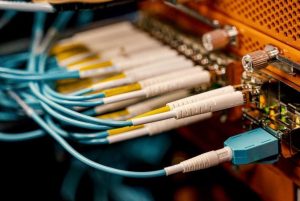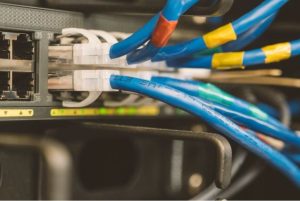Literal. Global. Connection. We rely on it and even take it for granted. The world wide web has us entangled with one another and with our dependency on the network we’ve created.
Arguably the most significant technological advancement of modern times, computer networking has evolved over time and has been no small feat, yet we hold it in our pockets and expect nothing less than immediacy. When it comes to technological expectations, the margin of error must be minimum, and that’s infinitely impressive given how vast the world’s network is.

Getting Technical: Data Transmission
Nowadays, there are wireless or direct cable options to link laptops, desktop computers, mobile phones, tablets, network infrastructure, and other devices to the Internet. However, regarding a residential to the worldwide networks’, the following are some of the most often utilized connections:
Cabling
Fiber Optic Cable – Fiber optic cable is a thin glass piece housed in a protective layer. These types of cable transfer data via light waves. Since the transmission medium is glass, it can send large amounts of data over long distances. Fiber optic is ideal for connecting locations spread apart or connections requiring a large amount of bandwidth transmission at high speeds.
Twisted Pair Cable – There are multiple variations of twisted pair cable, but the most common would be CAT5, CAT6, and CAT7 cables. These cables are made up of multiple copper wires that are each individually protected. They are generally used for inner building connectivity for phones, computers, wireless access points, and networking equipment rack for said location. Twisted pair is generally the go-to option when connecting devices that require less than 10GbE connections, like connecting a general workstation to a switch. Since the strands are made of copper, electricity can be sent through the cable powering access points, phones, security cameras, or other devices, known as PoE (Power Over Ethernet).
Coaxial Cable – This cable comprises one solid copper or copper-plated steel core, an inner dielectric shield, a copper shield, and an outer plastic protector. These are used as a method to carry data by radio frequency signals. The benefit of coaxial cables is that due to the makeup of the cable, it can be installed next to metal materials and is resistant to external electromagnetic interfaces. These can commonly be found connecting to a home or business providing Internet and or TV.
Cable management is also a critical component. Poor cable placement is not just unsightly; it can also obstruct airflow in a network rack, preventing heated air from being adequately discharged and preventing cool air from entering. Air damming caused by cables can cause equipment to overheat and fail over time, resulting in significant downtime.
Structured cabling methods, on the other hand, are used by well-managed facilities to provide consistent performance and ease of use. Taking some time to browse pictures of beautiful cable management can be an awe-inspiring moment, a work of art.
Wireless
Now that we’ve shed light on the most standard networking cabling options, let’s briefly touch on wireless connectivity.
- Wireless Router – For small physical areas that need wireless coverage like small to medium sized houses or small businesses, a wireless router should do the trick. These network devices not only route data but also allow devices to wirelessly connect to that network utilizing just 1 device. The range of the wireless signal is heavily dependent on a couple of factors. First being the protocol the wireless band it is utilizing and what obstructions are in the way like floors or walls.
- Wireless Access Points – When needing to cover a larger area and provide an easier scaling option, Wireless Access Points are often utilized. These network devices are generally installed on ceilings and will provide wireless coverage for a specified area. Access points are generally connected via Twisted Pair Cables to a PoE (Power over ethernet) switch, router, or wireless LAN controller. This allows a company to scale from one access point to thousands depending on the coverage that is required.
The Backbone and Connection Points
Cell Towers
Nowadays, cell towers are a predominant way people remain connected to the internet regardless of their location. As of 2020, there were almost half a million cell towers in the U.S. alone. That marks a quadrupling of the number of cell towers between 2000 and 2020. On top of the number of cell towers growing, newer cell towers also continue to become more effective with new data towers able to cover a 50-150km range. Pretty soon, we’ll be able to remain connected in all parts of the country regardless of how remote the location.
Marine Cables
When it comes to connecting across landmasses, marine cables connect continents and islands to each other. These cables are generally made up of fiber cables housed in a very thick layer of protective material to endure the ocean and seas. The first transatlantic telegraph cable was installed in the 1850s. Nowadays, almost every landmass has a marine cable connecting it to the world. TeleGeography maintains an incredible interactive map of all the marine cables in the world showcasing how they cover every major coastline and connect to even the most remote islands in the South Pacific Ocean. How these undersea cables are installed is yet another impressive feat.
Data Centers
Data centers are a pinnacle point in the architecture of the global network. Like any other user, a data center connects to the internet over a dedicated service provider’s line where it can direct traffic or deliver data requests. Unlike a traditional building, data centers, on the other hand, generally contain many connections from various suppliers, allowing them to provide multiple options to their consumers. Zooming out, when you send that email, visit a webpage, or talk on a cellular device, the data transmission is going through a variety of these types of cables and passing through potentially dozens of datacenters, all in milliseconds. On top of being centralized points of connections, many companies who lease or own rack space offer multiple services ranging from security services, storage options, web or application hosting like ERP or CRMs.
What’s in store for the future?
If submarine fiber optic cables, satellites, and super speed are our reality, what could be next? The possibilities expand exponentially alongside daily advances in networking technology. Our only limitation may be our resources. Refurbishing, recycling and reusing is our future. Dedicated Networks Inc. does just that to ensure that the future of technology reaches no end.


